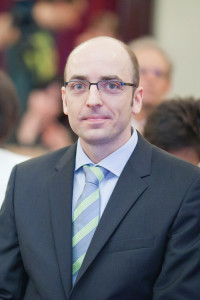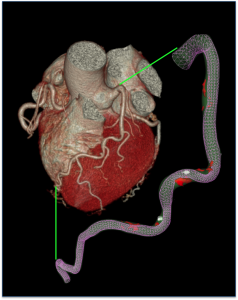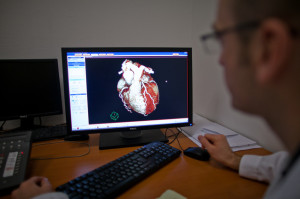 Dr. Pál Maurovich-Horvat cardiologist, assistant professor at Semmelweis University’s Cardiovascular Centre participated in a Nature Reviews Cardiology publication as first author. Along with his Hungarian and American co-authors, they discussed the latest results in the diagnosis of atherosclerotic plaques on coronary walls and the future possibilities in CT imaging. The aim of the methods outlined in the Nature summary is the early diagnosis or prevention of dangerous vulnerable coronary plaques which can cause heart attacks or sudden cardiac failures.
Dr. Pál Maurovich-Horvat cardiologist, assistant professor at Semmelweis University’s Cardiovascular Centre participated in a Nature Reviews Cardiology publication as first author. Along with his Hungarian and American co-authors, they discussed the latest results in the diagnosis of atherosclerotic plaques on coronary walls and the future possibilities in CT imaging. The aim of the methods outlined in the Nature summary is the early diagnosis or prevention of dangerous vulnerable coronary plaques which can cause heart attacks or sudden cardiac failures.
Mortality statistics are dominated by cardiovascular diseases, the majority of which can only be tackled through early prevention. Heart attacks or sudden cardiac failures are the first symptoms in two-third of coronary disease cases. Therefore the identification of potentially exposed patients is a fundamental challenge. The main objective of the joint MTA-SE “Momentum” research group, led by Dr. Pál Maurovich-Horvat, is the timely identification of dangerous plaques. According to the Nature publication, the prevention is aimed to be achieved through the use of biomarkers, cardiac CT imaging and the combination of rheological simulations and mathematical methods.
 Coronary plaques can be uniquely displayed by the 256- slice CT scanner which has been in use at the Cardiovascular Centre since 2010. This is the only cardiology centre in the country that has a cardiac CT scanner at its disposal for everyday procedures. The scanner is able to take a 3D picture of the patient’s chest and heart between two heartbeats; thus the coronary CT scanner – thanks to its high speed – can capture the heart in a motionless state. With the ability of achieving less than 1mm resolution, the modern computer tomography machine contributes to the early diagnosis of coronary plaques and stenosis. It is also important that it can distinguish between harmful and harmless plaques. The “Momentum” research group works in close cooperation with the Budapest University of Technology and Economics on the comprehensive summary of coronary plaques which features rheological simulations and complex mathematical models.
Coronary plaques can be uniquely displayed by the 256- slice CT scanner which has been in use at the Cardiovascular Centre since 2010. This is the only cardiology centre in the country that has a cardiac CT scanner at its disposal for everyday procedures. The scanner is able to take a 3D picture of the patient’s chest and heart between two heartbeats; thus the coronary CT scanner – thanks to its high speed – can capture the heart in a motionless state. With the ability of achieving less than 1mm resolution, the modern computer tomography machine contributes to the early diagnosis of coronary plaques and stenosis. It is also important that it can distinguish between harmful and harmless plaques. The “Momentum” research group works in close cooperation with the Budapest University of Technology and Economics on the comprehensive summary of coronary plaques which features rheological simulations and complex mathematical models.
 Dr. Pál Maurovich-Horvat and his co-authors, Dr. Béla Merkely, director of the Cardiovascular Centre, Dr. Maros Ferencik (Harvard University), Dr. Szilárd Vörös (Stony Brook University) and Dr. Udo Hoffmann (Harvard University) also shed light on the fact that the only known effective prevention of coronary diseases is the unique imaging process which – apart from the mortality rate – reduces minor damages as well. The use of coronary CT scans – despite the low radiation dose – is only justified in case of patients with chest complaints who are only at a moderate risk of being affected by a cardiovascular disease.
Dr. Pál Maurovich-Horvat and his co-authors, Dr. Béla Merkely, director of the Cardiovascular Centre, Dr. Maros Ferencik (Harvard University), Dr. Szilárd Vörös (Stony Brook University) and Dr. Udo Hoffmann (Harvard University) also shed light on the fact that the only known effective prevention of coronary diseases is the unique imaging process which – apart from the mortality rate – reduces minor damages as well. The use of coronary CT scans – despite the low radiation dose – is only justified in case of patients with chest complaints who are only at a moderate risk of being affected by a cardiovascular disease.
Dr. Pál Maurovich-Horvat – as a member of the Scientific Committee of the Hungarian Society of Cardiology – participates in the Hungarian cardiac CT education and as a winner of the Momentum Programme he and his research team play an active role in the early detection of coronary plaques.
Mária Mozer
Portrait photo: Attila Kovács – Semmelweis University
Translated by: Bonifac Makkai
